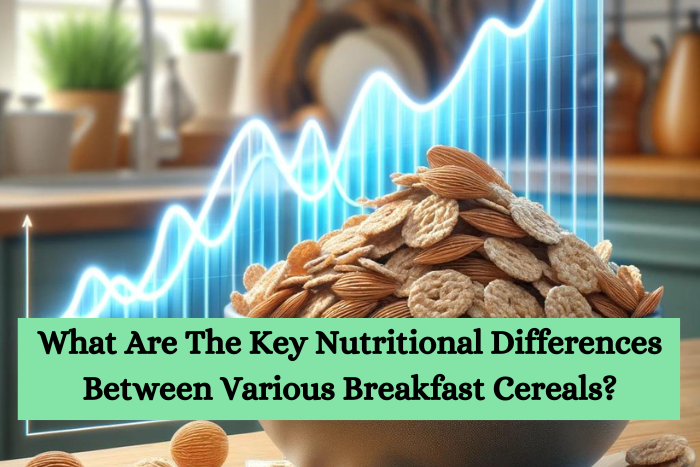- Breakfast cereals come in two primary types: whole grain, which offers more fiber, vitamins, and minerals, and refined grain, often enriched but less nutritionally complete.
- It’s essential to read nutritional labels carefully, looking beyond marketing claims to assess serving size, calorie count, fiber, and nutrient content, akin to how one might scrutinize a food menu’s fine print for hidden calorie-rich items.
- Understanding macronutrients (proteins, carbohydrates, and fats) in cereals is key, as these impact energy levels and health.
- The content of fiber and added sugars in cereals significantly affects their nutritional value.
- Personal dietary needs and preferences should guide cereal selection, balancing health benefits with enjoyment of the food.
Breakfast cereals have become a staple in many households, acclaimed for their convenience and variety. I know navigating the cereal aisle can be overwhelming with bountiful boxes boasting an array of colors, characters, and claims.
This section aims to simplify that choice by clarifying what breakfast cereals are and their place in a nourishing diet. Cereals come primarily in two categories: those made with whole grains and those with refined grains.
Whole grain cereals contain all parts of the grain, offering more fiber, vitamins, and minerals. Refined grain options, though often enriched with vitamins and minerals, may lack the natural nutritional completeness of their whole-grain counterparts.
🌾 Whole Grain vs. Refined Grain Cereals 🥣 |
|
|---|---|
| Whole Grain Cereals | Refined Grain Cereals |
| Contain all parts of the grain kernel: bran, germ, and endosperm. | Have most of the bran and germ removed during processing. |
| Higher in fiber, vitamins, and minerals. | Often enriched with vitamins and minerals, but less nutritionally diverse. |
| Can help reduce the risk of heart disease, diabetes, and other health conditions. | May lead to quicker energy spikes and crashes, impacting blood sugar levels. |
| 🌿 Naturally nutritious and often considered more healthful. | 🍞 Tend to be more processed with fewer natural nutrients. |
| Brought to You by athomewithtai.com | |
A key strategy I always recommend is inspecting the nutritional facts label. It’s essential to look beyond the front-of-the-box promises to understand the true health value of a cereal.
Paying attention to servings per container, calorie count, and the presence of dietary fiber, vitamins, and minerals can guide you to make an informed choice. What’s next?
We will delve into the details of the macros and micros that define these breakfast options. From assessing the protein to decoding the sugar content, understanding these elements can lead you to a cereal that supports your health goals.
Breaking Down the Bowl: Comparing Macros and Micros

As someone conscientiously navigating the breakfast landscape, you need to understand how to compare the macronutrients – proteins, carbohydrates, and fats – found in cereals. These elements are fundamental to our diet, but their ratios can vary greatly among cereal brands and types.
Protein content in cereals can differ widely. Your body uses protein to repair tissues and make enzymes and hormones.
While some cereals offer a decent serving of protein, others fall short. Check the label to ensure you’re starting the day with a good protein source.
Carbohydrates are an item to watch closely. They are the primary source of energy for our brains and muscles.
Whole grain cereals generally offer complex carbohydrates, which provide a steady release of energy. In contrast, cereals with refined grains or high sugar content can lead to quicker energy spikes, followed by crashes.
Fats are less prominent in cereals, but it’s wise to look for cereals with beneficial fats like those from nuts or seeds. These fats are essential for brain health and can contribute to satiety, helping you feel full longer.
When it comes to fiber content, the higher, the better. Fiber aids digestion and can help regulate blood sugar levels.
It’s a cornerstone of any cereal claiming to be nutritious. Some cereals even include added functional fibers to boost benefits.
As we pivot to micronutrients, remember that cereals often come fortified with vitamins and minerals. These additions can help meet daily nutritional needs but remember, they don’t replace the diverse nutrients found in whole foods.
Sugar is the final, crucial piece of the cereal puzzle. A high-sugar cereal can undermine your nutrition.
Aim to select cereals with low added sugars to avoid unnecessary calorie intake and the risk of increasing your blood sugar levels.
Making an Informed Choice: Selecting the Right Cereal for You

When it comes to picking the right cereal, personal dietary needs and preferences play a significant role. If you’re monitoring your blood sugar levels or aiming for weight management, low-sugar options are worth considering.
For those with gluten sensitivity, gluten-free variants offer a safe breakfast without compromising on taste. It’s not just about health – the flavor is important too.
You should enjoy your meals. A common mistake is choosing a cereal based solely on its nutritional merits; if you don’t like it, you’re not going to eat it.
Find a balance between what pleases your palate and what fulfills your body’s needs. There’s room for flexibility.
Add a scoop of nuts or a handful of berries to enhance your cereal’s nutritional profile. Such additions can increase protein intake, provide healthy fats, and boost fiber, not to mention adding a variety of textures and tastes.
My Final Thoughts
Be wary of health claims that seem too good to be true. Cereal boxes often advertise benefits like ‘heart-healthy’ or ‘excellent source of vitamins’ which can be misleading.
It’s crucial to read the ingredients list and nutrition facts to ensure the claims match the product’s actual content. How do you balance the nutritional value and taste preferences when selecting a breakfast cereal, and what changes could make this choice easier or more aligned with your health goals?
Let me know in the comments below!
FAQ Section

1. What are the benefits of eating whole-grain cereals?
- Whole grain cereals retain all parts of the grain, including the bran, germ, and endosperm, which means they are richer in fiber, vitamins, and minerals compared to refined grain cereals.
- Consuming whole grain cereals can contribute to better digestive health, improved cholesterol levels, and a lower risk of heart disease and type 2 diabetes.
2. How can I tell if a cereal is truly whole grain?
- Look for the words “whole grain” as the first ingredient on the label. This indicates that the cereal is primarily made from whole grains.
- Check for a whole grain stamp or certification on the packaging, which can help assure that the product meets specific whole grain criteria.
3. Are cereals with added vitamins and minerals just as good as naturally nutrient-rich cereals?
- Cereals with added vitamins and minerals can help meet nutritional deficiencies, but they may not provide the same broad spectrum of nutrients found in naturally nutrient-rich cereals.
- Whole foods and cereals are naturally rich in nutrients and often contain additional beneficial compounds like antioxidants and phytochemicals that aren’t added to fortified cereals.
4. How important is the sugar content in cereal, and what should I look for?
- High sugar content in cereal can lead to energy spikes and crashes and contribute to health issues like obesity and type 2 diabetes. It’s crucial to choose cereals with low added sugars.
- Look for cereals that have less than 5 grams of sugar per serving. Be aware of terms like corn syrup, fructose, and sucrose, which indicate added sugars.
5. Can changing my breakfast cereal impact my overall health?
- Yes, choosing a healthier breakfast cereal can significantly impact your overall health by providing essential nutrients and preventing overconsumption of sugars and refined grains.
- A nutritious breakfast cereal can set the tone for healthier eating throughout the day, leading to better energy management, improved digestion, and long-term health benefits.
- Why Are Breakfast Juices a Smart Choice?

- What’s the Best Beverage for Diabetics at Breakfast?

- What’s the Best Protein Drink for Your Morning Routine?

- Can Breakfast Drinks Really Boost Your Weight Loss?

- Ever Tried Turkish Coffee or Indian Lassi?

- Is Your Morning Drink Boosting Your Health or Calories?


I’m Diane, a culinary enthusiast who loves to share my cooking adventures and knowledge with you.
This blog is my cozy corner on the internet where I unravel the secrets behind making everyday cooking simple, enjoyable, and downright delicious.
Whether it’s unlocking the flavor potential in chicken or figuring out why your mashed potato cakes won’t hold together, I’m here to guide you through.
Join me as we explore various dishes, solve common kitchen dilemmas, and discover new recipes that will make you fall in love with cooking all over again.
Cooking is an adventure that’s best shared, so let’s get started!

